- ▶
- Heaters/Source
- ▶
- Agilent Heaters and SensorsMass Spectrometry, Scientific Supplies & ManufacturingScientific Instrument Services 5973 Source Heater Tamper Resistant Allen Wrench 5973/5975 Quad Sensor 5985 Source Heater Assembly Agilent Interface Heater Assembly 5971 Interface Heater

- ▶
- Reference Material on InstrumentationArticle - A High Temperature Direct Probe for a Mass Spectrometer Design of a Direct Exposure Probe and Controller for use ona Hewlett-Packard 5989 Mass Spectrometer SIS AP1000 AutoProbe™ SIS AP2000 AutoProbe™ - Description of System HPP7: Direct Probe Electronics Console HPP7: Direct Probe for the Agilent (HP) 5973/5975 MSD HPP7: HP Direct Probe Application Notes HPP7: Installation Directions for the Direct Probe HPP7: Side Cover for the HP 5973 MSD HPP7: Support HPP7: Probe Inlet System for the Agilent (HP) 5973 and 5975 MSD with Automatic Indexed Stops HPP7: Theory of Operation of the Direct Probe and Probe Inlet System Direct Thermal Extraction Thermal Desorption Application Notes Environmental Thermal Desorption Application Notes Food Science Thermal Desorption Application Notes Forensic Thermal Desorption Application Notes GC Cryo-Trap Application Notes Headspace Application Notes Purge & Trap Thermal Desorption Application Notes Theory of Operation of the AutoDesorb® System AutoDesorb Notes for SIS Dealers Adsorbent Resin Application Notes Installation of the Short Path Thermal Desorption System on Agilent (HP) and Other GCs Installation of the Short Path Thermal Desorption System on a Varian 3400 GC AutoDesorb® System Development Team Thermal Desorption Applications and Reference Materials Installation of the Short Path Thermal Desorption System - TD5 Part I - Design & Operation of the Short Path ThermalDesorption System Installation Instructions for the Model 951 GC Cryo-Trap on the HP 5890 Series GC Installation Instructions for the Model 961 GC Cryo-Trap on the HP 5890 Series GC Operation of the Model 951/961 GC Cryo-Trap SIS GC Cryo Traps - Theory of Operation NIST/EPA/NIH Mass Spectral Enhancements - 1998 version (NIST98) SIMION 3D Ion Optics Class Mass Spectrometer Source Cleaning Methods MS Tip: Mass Spectrometer Source Cleaning Procedures Mass Spec Source Cleaning Procedures Micro-Mesh® Abrasive Sheets Research Papers Using New Era Syringe Pump Systems EI Positive Ion Spectra for Perfluorokerosene (PFK) Cap Liner Information How do I convert between fluid oz and milliliters? Which bottle material should I choose? Which bottle mouth should I choose? The Bottle Selection Guide CGA Connections for Gas Tanks Chemical Reaction Interface Mass Spectrometry (CRIMS)

- TD
- ▶
- AccessoriesTD Supply Kit Desorption Tubes Adsorbent Resins Desorption Tube Needles Desorption Tube Seals Desorption System Fittings GC Cryo-Trap Extraction Cell TD Sample Loader Prepacked, Conditioned Desorption Tubes Desorption Tube Packing Accessories Stainless Steel Purge Heads Injection Port Liners Tenax TA Poster TD Application Notes Customer Service

- LiteratureApplication Notes Adsorbent Resins Guide Mass Spec Tips SDS Sheets FAQ MS Calibration Compound Spectra Manuals MS Links/Labs/ Organizations MS Online Tools Flyers on Products/Services Scientific Supplies Catalog About Us NextAdvance Bullet Blender® Homogenizer Protocols Micro-Mesh® Literature Instrumentation Literature Agilent GC/MS Literature SIS News / E-Mail Newsletter NIST MS Database - Update Notifications

- ▶
- Purge & Trap Thermal Desorption Application NotesNote 97: Flavor Profiles of Imported and Domestic Beers by Purge & Trap Thermal Desorption GC/MS Note 93: Detection of Benzene in Carbonated Beverages with Purge & Trap Thermal Desorption GC/MS Note 43: Volatile Organic Composition In Blueberries Note 42: The Influence of Pump Oil Purity on Roughing Pumps Note 38: A New Micro Cryo-Trap For Trapping Of Volatiles At the Front Of a GC Capillary Column Note 35: Volatile Organics Composition of Cranberries Note 34: Selection Of Thermal Desorption and Cryo-Trap Parameters In the Analysis Of Teas Note 33: Changes in Volatile Organic Composition in Milk Over Time Note 32: Selection and Use of Adsorbent Resins for Purge and Trap Thermal Desorption Applications Note 31: Volatile Organic Composition in Several Cultivars of Peaches Note 30: Comparison Of Cooking Oils By Direct Thermal Extraction and Purge and Trap GC/MS Note 26: Volatile Organics Present in Recycled Air Aboard a Commercial Airliner Note 25: Flavor and Aroma in Natural Bee Honey Note 23: Frangrance Qualities in Colognes Note 22: Comparison Of Volatile Compounds In Latex Paints Note 21: Detection and Identification Of Volatile and Semi-Volatile Organics In Synthetic Polymers Used In Food and Pharmaceutical Packaging Note 20: Using Direct Thermal Desorption to Assess the Potential Pool of Styrene and 4-Phenylcyclohexene In Latex-Backed Carpets Note 18: Determination of Volatile Organic Compounds In Mushrooms Note 17: Identification of Volatile Organics in Wines Over Time Note 16: Analysis of Indoor Air and Sources of Indoor Air Contamination by Thermal Desorption Note 14: Identification of Volatiles and Semi-Volatiles In Carbonated Colas Note 8: Detection of Volatile Organic Compounds In Liquids Utilizing the Short Path Thermal Desorption System Note 3: Indoor Air Pollution Note 2: Detection of Arson Accelerants Using Dynamic Headspace with Tenax® Cartridges Thermal Desorption and Cryofocusing

- Thermal Desorption Applications and Reference MaterialsDirect Thermal Extraction Headspace Environmental Food Science Applications Pharmaceuticals Forensic Note 103: EPA Method 325B, Novel Thermal Desorption Instrument Modification to Improve Sensitivity Note 102: Identification of Contaminants in Powdered Beverages by Direct Extraction Thermal Desorption GC/MS Note 101: Identification of Contaminants in Powdered Foods by Direct Extraction Thermal Desorption GC/MS Note 100: Volatile and Semi-Volatile Profile Comparison of Whole Versus Cracked Versus Dry Homogenized Barley Grains by Direct Thermal Extraction Note 99: Volatile and Semi-Volatile Profile Comparison of Whole vs. Dry Homogenized Wheat, Rye and Barley Grains by Direct Thermal Extraction GC/MS Note 98: Flavor and Aroma Profiles of Truffle Oils by Thermal Desorption GC/MS Note 97: Flavor Profiles of Imported and Domestic Beers by Purge & Trap Thermal Desorption GC/MS Note 95: Detection of Explosives on Clothing Material by Direct and AirSampling Thermal Desorption GC/MS Note 94: Detection of Nepetalactone in the Nepeta Cataria Plant by Thermal Desorption GC/MS Note 93: Detection of Benzene in Carbonated Beverages with Purge & Trap Thermal Desorption GC/MS Note 88: Analysis of Silicone Contaminants on Electronic Components by Thermal Desorption GC-MS Note 84: Vacuum Pump Exhaust Filters - Charcoal Exhaust Traps Note 83: Vacuum Pump Exhaust Filters - Oil Mist Eliminators Note 82: Vacuum Pump Exhaust Filters Note 80: Design, Development and Testing of a Microprocessor ControlledAutomated Short Path Thermal Desorption Apparatus Note 79: Volatile Organic Compounds From Electron Beam Cured and Partially Electron Beam Cured Packaging Using Automated Short Path Thermal Desorption Note 77: The Determination of Volatile Organic Compounds in VacuumSystem Components Note 75: An Apparatus for Sampling Volatile Organics From LivePlant Material Using Short Path Thermal Desorption Note 73: The Analysis of Perfumes and their Effect on Indoor Air Pollution Note 71: Flavor Profile Determination of Rice Samples Using Shor tPath Thermal Desorption GC Methods Note 65: Determination of Ethylene by Adsorbent Trapping and Thermal Desorption - Gas Chromatography Note 64: Comparison of Various GC/MS Techniques For the Analysis of Black Pepper (Piper Nigrum) Note 63: Determination of Volatile and Semi-Volatile Organics in Printer Toners Using Thermal Desorption GC Techniques Note 60: Programmable Temperature Ramping of Samples Analyzed ViaDirect Thermal Extraction GC/MS Note 57: Aroma Profiles of Lavandula species Note 55: Seasonal Variation in Flower Volatiles Note 54: Identification of Volatile Organic Compounds in Office Products Note 43: Volatile Organic Composition In Blueberries Note 42: The Influence of Pump Oil Purity on Roughing Pumps Note 41: Hydrocarbon Production in Pine by Direct Thermal Extraction Note 40: Comparison of Septa by Direct Thermal Extraction Note 39: Comparison of Sensitivity Of Headspace GC, Purge and Trap Thermal Desorption and Direct Thermal Extraction Techniques For Volatile Organics Note 38: A New Micro Cryo-Trap For Trapping Of Volatiles At the Front Of a GC Capillary Column Note 37: Volatile Organic Emissions from Automobile Tires Note 36: Identification Of Volatile Organic Compounds In a New Automobile Note 35: Volatile Organics Composition of Cranberries Note 34: Selection Of Thermal Desorption and Cryo-Trap Parameters In the Analysis Of Teas Note 33: Changes in Volatile Organic Composition in Milk Over Time Note 32: Selection and Use of Adsorbent Resins for Purge and Trap Thermal Desorption Applications Note 31: Volatile Organic Composition in Several Cultivars of Peaches Note 30: Comparison Of Cooking Oils By Direct Thermal Extraction and Purge and Trap GC/MS Note 29: Analysis Of Volatile Organics In Oil Base Paints By Automated Headspace Sampling and GC Cryo-Focusing Note 28: Analysis Of Volatile Organics In Latex Paints By Automated Headspace Sampling and GC Cryo-Focusing Note 27: Analysis of Volatile Organics In Soils By Automated Headspace GC Note 26: Volatile Organics Present in Recycled Air Aboard a Commercial Airliner Note 25: Flavor and Aroma in Natural Bee Honey Note 24: Selection of GC Guard Columns For Use With the GC Cryo-Trap Note 23: Frangrance Qualities in Colognes Note 22: Comparison Of Volatile Compounds In Latex Paints Note 21: Detection and Identification Of Volatile and Semi-Volatile Organics In Synthetic Polymers Used In Food and Pharmaceutical Packaging Note 20: Using Direct Thermal Desorption to Assess the Potential Pool of Styrene and 4-Phenylcyclohexene In Latex-Backed Carpets Note 19: A New Programmable Cryo-Cooling/Heating Trap for the Cryo-Focusing of Volatiles and Semi-Volatiles at the Head of GC Capillary Columns Note 18: Determination of Volatile Organic Compounds In Mushrooms Note 17: Identification of Volatile Organics in Wines Over Time Note 16: Analysis of Indoor Air and Sources of Indoor Air Contamination by Thermal Desorption Note 14: Identification of Volatiles and Semi-Volatiles In Carbonated Colas Note 13: Identification and Quantification of Semi-Volatiles In Soil Using Direct Thermal Desorption Note 12: Identification of the Volatile and Semi-Volatile Organics In Chewing Gums By Direct Thermal Desorption Note 11: Flavor/Fragrance Profiles of Instant and Ground Coffees By Short Path Thermal Desorption Note 10: Quantification of Naphthalene In a Contaminated Pharmaceutical Product By Short Path Thermal Desorption Note 9: Methodologies For the Quantification Of Purge and Trap Thermal Desorption and Direct Thermal Desorption Analyses Note 8: Detection of Volatile Organic Compounds In Liquids Utilizing the Short Path Thermal Desorption System Note 7: Chemical Residue Analysis of Pharmaceuticals Using The Short Path Thermal Desorption System Note 6: Direct Thermal Analysis of Plastic Food Wraps Using the Short Path Thermal Desorption System Note 5: Direct Thermal Analysis Using the Short Path Thermal Desorption System Note 4: Direct Analysis of Spices and Coffee Note 3: Indoor Air Pollution Note 2: Detection of Arson Accelerants Using Dynamic Headspace with Tenax® Cartridges Thermal Desorption and Cryofocusing Note 1: Determination of Off-Odors and Other Volatile Organics In Food Packaging Films By Direct Thermal Analysis-GC-MS

- ▶
- Food Science Thermal Desorption Application NotesNote 102: Identification of Contaminants in Powdered Beverages by Direct Extraction Thermal Desorption GC/MS Note 101: Identification of Contaminants in Powdered Foods by Direct Extraction Thermal Desorption GC/MS Note 98: Flavor and Aroma Profiles of Truffle Oils by Thermal Desorption GC/MS Note 93: Detection of Benzene in Carbonated Beverages with Purge & Trap Thermal Desorption GC/MS Note 43: Volatile Organic Composition In Blueberries Note 41: Hydrocarbon Production in Pine by Direct Thermal Extraction Note 35: Volatile Organics Composition of Cranberries Note 33: Changes in Volatile Organic Composition in Milk Over Time Note 31: Volatile Organic Composition in Several Cultivars of Peaches Note 30: Comparison Of Cooking Oils By Direct Thermal Extraction and Purge and Trap GC/MS Note 25: Flavor and Aroma in Natural Bee Honey Note 21: Detection and Identification Of Volatile and Semi-Volatile Organics In Synthetic Polymers Used In Food and Pharmaceutical Packaging Note 18: Determination of Volatile Organic Compounds In Mushrooms Note 17: Identification of Volatile Organics in Wines Over Time Note 14: Identification of Volatiles and Semi-Volatiles In Carbonated Colas Note 12: Identification of the Volatile and Semi-Volatile Organics In Chewing Gums By Direct Thermal Desorption Note 11: Flavor/Fragrance Profiles of Instant and Ground Coffees By Short Path Thermal Desorption Note 9: Methodologies For the Quantification Of Purge and Trap Thermal Desorption and Direct Thermal Desorption Analyses Note 8: Detection of Volatile Organic Compounds In Liquids Utilizing the Short Path Thermal Desorption System Note 6: Direct Thermal Analysis of Plastic Food Wraps Using the Short Path Thermal Desorption System Note 5: Direct Thermal Analysis Using the Short Path Thermal Desorption System Note 4: Direct Analysis of Spices and Coffee Note 1: Determination of Off-Odors and Other Volatile Organics In Food Packaging Films By Direct Thermal Analysis-GC-MS

- Application NotesNote 103: EPA Method 325B, Novel Thermal Desorption Instrument Modification to Improve Sensitivity Note 102: Identification of Contaminants in Powdered Beverages by Direct Extraction Thermal Desorption GC/MS Note 101: Identification of Contaminants in Powdered Foods by Direct Extraction Thermal Desorption GC/MS Note 100: Volatile and Semi-Volatile Profile Comparison of Whole Versus Cracked Versus Dry Homogenized Barley Grains by Direct Thermal Extraction Note 99: Volatile and Semi-Volatile Profile Comparison of Whole vs. Dry Homogenized Wheat, Rye and Barley Grains by Direct Thermal Extraction GC/MS Note 98: Flavor and Aroma Profiles of Truffle Oils by Thermal Desorption GC/MS Note 97: Flavor Profiles of Imported and Domestic Beers by Purge & Trap Thermal Desorption GC/MS Note 96: Reducing Warping in Mass Spectrometer Filaments, with SISAlloy® Yttria/Rhenium Filaments Note 95: Detection of Explosives on Clothing Material by Direct and AirSampling Thermal Desorption GC/MS Note 94: Detection of Nepetalactone in the Nepeta Cataria Plant by Thermal Desorption GC/MS Note 93: Detection of Benzene in Carbonated Beverages with Purge & Trap Thermal Desorption GC/MS Note 92: Yttria Coated Mass Spectrometer Filaments Note 91: AutoProbe DEP Probe Tip Temperatures Note 90: An Automated MS Direct Probe for use in an Open Access Environment Note 89: Quantitation of Organics via a Mass Spectrometer Automated Direct Probe Note 88: Analysis of Silicone Contaminants on Electronic Components by Thermal Desorption GC-MS Note 87: Design and Development of an Automated Direct Probe for a Mass Spectrometer Note 86: Simulation of a Unique Cylindrical Quadrupole Mass Analyzer Using SIMION 7.0. Note 85: Replacing an Electron Multiplier in the Agilent (HP) 5973 MSD Note 84: Vacuum Pump Exhaust Filters - Charcoal Exhaust Traps Note 83: Vacuum Pump Exhaust Filters - Oil Mist Eliminators Note 82: Vacuum Pump Exhaust Filters Note 81: Rapid Bacterial Chemotaxonomy By DirectProbe/MSD Note 80: Design, Development and Testing of a Microprocessor ControlledAutomated Short Path Thermal Desorption Apparatus Note 79: Volatile Organic Compounds From Electron Beam Cured and Partially Electron Beam Cured Packaging Using Automated Short Path Thermal Desorption Note 78: A New Solution to Eliminate MS Down-Time With No-Tool-Changing of Analytical GC Columns Note 77: The Determination of Volatile Organic Compounds in VacuumSystem Components Note 76: Determination of the Sensitivity of a CRIMS System Note 75: An Apparatus for Sampling Volatile Organics From LivePlant Material Using Short Path Thermal Desorption Note 74: Examination of Source Design in Electrospray-TOF Using SIMION 3D Note 73: The Analysis of Perfumes and their Effect on Indoor Air Pollution Note 72: 1998 Version of the NIST/EPA/NIH Mass Spectral Library, NIST98 Note 71: Flavor Profile Determination of Rice Samples Using Shor tPath Thermal Desorption GC Methods Note 70: Application of SIMION 6.0 To a Study of the Finkelstein Ion Source: Part II Note 69: Application of SIMION 6.0 To a Study of the Finkelstein Ion Source: Part 1 Note 68: Use of a PC Plug-In UV-Vis Spectrometer To Monitor the Plasma Conditions In GC-CRIMS Note 67: Using Chemical Reaction Interface Mass Spectrometry (CRIMS) To Monitor Bacterial Transport In In Situ Bioremediation Note 66: Probe Tip Design For the Optimization of Direct Insertion Probe Performance Note 65: Determination of Ethylene by Adsorbent Trapping and Thermal Desorption - Gas Chromatography Note 64: Comparison of Various GC/MS Techniques For the Analysis of Black Pepper (Piper Nigrum) Note 63: Determination of Volatile and Semi-Volatile Organics in Printer Toners Using Thermal Desorption GC Techniques Note 62: Analysis of Polymer Samples Using a Direct Insertion Probe and EI Ionization Note 61: Analysis of Sugars Via a New DEP Probe Tip For Use With theDirect Probe On the HP5973 MSD Note 60: Programmable Temperature Ramping of Samples Analyzed ViaDirect Thermal Extraction GC/MS Note 59: Computer Modeling of a TOF Reflectron With Gridless Reflector Using SIMION 3D Note 58: Direct Probe Analysis and Identification of Multicomponent Pharmaceutical Samples via Electron Impact MS Note 57: Aroma Profiles of Lavandula species Note 56: Mass Spec Maintenance & Cleaning Utilizing Micro-Mesh® Abrasive Sheets Note 55: Seasonal Variation in Flower Volatiles Note 54: Identification of Volatile Organic Compounds in Office Products Note 53: SIMION 3D v6.0 Ion Optics Simulation Software Note 52: Computer Modeling of Ion Optics in Time-of-Flight mass Spectrometry Using SIMION 3D Note 51: Development and Characterization of a New Chemical Reaction Interface for the Detection of Nonradioisotopically Labeled Analytes Using Mass Spectrometry (CRIMS) Note 50: The Analysis of Multiple Component Drug Samples Using a Direct Probe Interfaced to the HP 5973 MSD Note 49: Analysis of Cocaine Utilizing a New Direct Insertion Probe on a Hewlett Packard 5973 MSD Note 48: Demonstration of Sensitivity Levels For the Detection of Caffeine Using a New Direct Probe and Inlet for the HP 5973 MSD Note 47: The Application Of SIMION 6.0 To Problems In Time-of-Flight Mass Spectrometry Note 46: Delayed Extraction and Laser Desorption: Time-lag Focusing and Beyond Note 45: Application of SIMION 6.0 to Filament Design for Mass Spectrometer Ionization Sources Note 44: The Design Of a New Direct Probe Inlet For a Mass Spectrometer Note 43: Volatile Organic Composition In Blueberries Note 42: The Influence of Pump Oil Purity on Roughing Pumps Note 41: Hydrocarbon Production in Pine by Direct Thermal Extraction Note 40: Comparison of Septa by Direct Thermal Extraction Note 39: Comparison of Sensitivity Of Headspace GC, Purge and Trap Thermal Desorption and Direct Thermal Extraction Techniques For Volatile Organics Note 38: A New Micro Cryo-Trap For Trapping Of Volatiles At the Front Of a GC Capillary Column Note 37: Volatile Organic Emissions from Automobile Tires Note 36: Identification Of Volatile Organic Compounds In a New Automobile Note 35: Volatile Organics Composition of Cranberries Note 34: Selection Of Thermal Desorption and Cryo-Trap Parameters In the Analysis Of Teas Note 33: Changes in Volatile Organic Composition in Milk Over Time Note 32: Selection and Use of Adsorbent Resins for Purge and Trap Thermal Desorption Applications Note 31: Volatile Organic Composition in Several Cultivars of Peaches Note 30: Comparison Of Cooking Oils By Direct Thermal Extraction and Purge and Trap GC/MS Note 29: Analysis Of Volatile Organics In Oil Base Paints By Automated Headspace Sampling and GC Cryo-Focusing Note 28: Analysis Of Volatile Organics In Latex Paints By Automated Headspace Sampling and GC Cryo-Focusing Note 27: Analysis of Volatile Organics In Soils By Automated Headspace GC Note 26: Volatile Organics Present in Recycled Air Aboard a Commercial Airliner Note 25: Flavor and Aroma in Natural Bee Honey Note 24: Selection of GC Guard Columns For Use With the GC Cryo-Trap Note 23: Frangrance Qualities in Colognes Note 22: Comparison Of Volatile Compounds In Latex Paints Note 21: Detection and Identification Of Volatile and Semi-Volatile Organics In Synthetic Polymers Used In Food and Pharmaceutical Packaging Note 20: Using Direct Thermal Desorption to Assess the Potential Pool of Styrene and 4-Phenylcyclohexene In Latex-Backed Carpets Note 19: A New Programmable Cryo-Cooling/Heating Trap for the Cryo-Focusing of Volatiles and Semi-Volatiles at the Head of GC Capillary Columns Note 18: Determination of Volatile Organic Compounds In Mushrooms Note 17: Identification of Volatile Organics in Wines Over Time Note 16: Analysis of Indoor Air and Sources of Indoor Air Contamination by Thermal Desorption Note 14: Identification of Volatiles and Semi-Volatiles In Carbonated Colas Note 13: Identification and Quantification of Semi-Volatiles In Soil Using Direct Thermal Desorption Note 12: Identification of the Volatile and Semi-Volatile Organics In Chewing Gums By Direct Thermal Desorption Note 11: Flavor/Fragrance Profiles of Instant and Ground Coffees By Short Path Thermal Desorption Note 10: Quantification of Naphthalene In a Contaminated Pharmaceutical Product By Short Path Thermal Desorption Note 9: Methodologies For the Quantification Of Purge and Trap Thermal Desorption and Direct Thermal Desorption Analyses Note 8: Detection of Volatile Organic Compounds In Liquids Utilizing the Short Path Thermal Desorption System Note 7: Chemical Residue Analysis of Pharmaceuticals Using The Short Path Thermal Desorption System Note 6: Direct Thermal Analysis of Plastic Food Wraps Using the Short Path Thermal Desorption System Note 5: Direct Thermal Analysis Using the Short Path Thermal Desorption System Note 4: Direct Analysis of Spices and Coffee Note 3: Indoor Air Pollution Note 2: Detection of Arson Accelerants Using Dynamic Headspace with Tenax® Cartridges Thermal Desorption and Cryofocusing Note 1: Determination of Off-Odors and Other Volatile Organics In Food Packaging Films By Direct Thermal Analysis-GC-MS Tech No. "A" Note 14: Elimination of "Memory" Peaks in Thermal Desorption Improving Sensitivity in the H.P. 5971 MSD and Other Mass Spectrometers - Part I of II Improving Sensitivity in the H.P. 5971 MSD and Other Mass Spectrometers- Part II of II Adsorbent Resins Guide Development and Field Tests of an Automated Pyrolysis Insert for Gas Chromatography. Hydrocarbon Production in Pine by Direct Thermal Extraction A New Micro Cryo-Trap for the Trapping of Volatiles at the Front of a GC Capillary (019P) - Comparison of Septa by Direct Thermal Extraction Volatile Organic Composition in Blueberry Identification of Volatile Organic Compounds in Office Products Detection and Indentification of Volatiles in Oil Base Paintsby Headspace GC with On Column Cryo-Trapping Evaluation of Septa Using a Direct Thermal Extraction Technique INFLUENCE OF STORAGE ON BLUEBERRY VOLATILES Selection of Thermal Desorption and Cryo-Trap Parameters in the Analysis of Teas Redesign and Performance of a Diffusion Based Solvent Removal Interface for LC/MS The Design of a New Direct Probe Inlet for a Mass Spectrometer Analytes Using Mass Spectrometry (CRIMS) Application of SIMION 6.0 to Filament Design for Mass Spectrometer Ionization Sources A Student Guide for SIMION Modeling Software Application of SIMION 6.0 to Problems in Time-of-flight Mass Spectrometry Comparison of Sensitivity of Headspace GC, Purge and TrapThermal Desorption and Direct Thermal Extraction Techniques forVolatile Organics The Influence of Pump Oil Purity on Roughing Pumps Analysis of Motor Oils Using Thermal Desorption-Gas Chromatography-Mass Spectrometry IDENTIFICATION OF VOLATILE ORGANIC COMPOUNDS IN PAPER PRODUCTS Computer Modeling of Ion Optics in Time-of-Flight mass Spectrometry using SIMION 3D Seasonal Variation in Flower Volatiles Development of and Automated Microprocessor Controlled Gas chromatograph Fraction Collector / Olfactometer Delayed Extraction and Laser Desorption: Time-lag Focusing and Beyond A New Micro Cryo-Trap for the Trapping of Volatiles at the Front of a GC Column Design of a Microprocessor Controlled Short Path Thermal Desorption Autosampler Computer Modeling of Ion Optics in Time-of-Flight Mass Spectrometry Using SIMION 3D Thermal Desorption Instrumentation for Characterization of Odors and Flavors

- ▶
- Note 14: Identification of Volatiles and Semi-Volatiles In Carbonated Colas (This Page)
INTRODUCTION
A large number of volatile and semi-volatile organics are present in commercial beverages which are responsible for each of their unique flavors. With increased shelf life or exposure to environmental conditions the relative amounts of these organics can vary due to evaporation or chemical changes. Off-odors and unusual taste development occur in some carbonated colas with increased shelf life, or stored at temperatures higher than normal. Problems associated with off-odor/off-taste development are thought to be related to the manufacturer's formulation, interaction of the volatile components with the different types of container lining, or foreign material introduction. Previous studies showed the greatest odor problems were in bottles with ethylene vinyl acetate (EVA) closure liners containing titanium dioxide (1). These off-odors were probably due to the presence of terpene degradation products. Light intensity and temperature are also thought to influence off-odor development. Increased shelf life in varying light and temperature conditions may stimulate oxidative reactions. Wiley et al. (1) suggest that a turpentine-like off-odor development IS due to excess p-cymene in the cola resulting from increased shelf life at higher temperatures. The primary sources of p-cymene appear to be from the conversion of terpinene and limonene, natural constituents of lemon oils used in cola formulations. The purpose of this study is to analyze several brands of carbonated colas in aluminum cans to compare the flavor profiles of different manufactures' brands and to quantify cymene and limonene within these products. Quantification of cymene and limonene is conducted to determine their relationship of off-odor/off-taste development with increased shelf life.
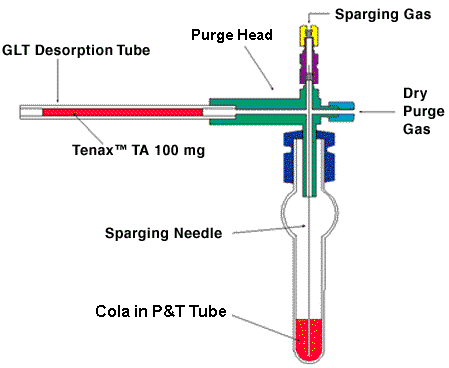
Figure 1 - Purge & Trap System
INSTRUMENTATION
A Purge & Trap System (Scientific Instrument Services, Ringoes, NJ) was used for the purging of the volatile and semi-volatile organics from the carbonated colas and subsequent trapping of the purged organic compounds on preconditioned glass-lined stainless steel desorption tubes (GLT) containing the porous polymer Tenax® TA. The Purge and Trap System (Figure 1) consists of a sparge gas inlet connected to a stainless steel purging needle that is inserted through an adaptor fitting into a 10 ml test tube. This purging needle provides for the helium gas flow through the cola sample to purge the organics from the liquid sample and carry them onto the adsorbent resin. The dry purge gas inlet is located at a right angle to the sparge gas inlet at the top of the apparatus. The purpose of the dry purge is to reduce the water vapor condensation on the adsorbent trap. This problem can be especially troublesome when isolating volatiles from aqueous solutions at high temperatures. Although the adsorbent traps packed with Tenax have a low affinity for water, it is inevitable that some condensation can occur in the trap due to the high relative humidity of the sparge gas as it exits the apparatus. When moisture condenses on the adsorbent, it can block the pores of the resin matrix and thereby drastically reduce the diffusion of volatile organics into the trapping resins. This will result in reduced trapping efficiency. The use of the dry purge will eliminate this problem of water condensation on the Tenax resin. Opposite the dry purge inlet is the connector for the GLT desorption tube containing the adsorbent resin. The sample collection vessel for this analysis was a 10.0 ml purge and trap glass test tube. A heater blanket was placed around this glass tube to heat the tube and contents to 50 degrees C using a regulated temperature controller. This heating of the sample served to reduce the viscosity of the cola to permit better purging of the liquid sample as well as higher molecular weight compounds from the liquid samples for subsequent trapping on the adsorbent trap.
All experiments were conducted using a Scientific Instrument Services Model TD-2 Short Path Thermal Desorption System accessory (2) connected to the injection port of an HP 5890 Series II GC interfaced to an HP 5971 Mass Selective Detector. The mass spectrometer was operated in the electron impact mode (EI) at 70 eV and scanned from 35 to 350 daltons during the GC run for the total ion chromatogram. The mass spectrometer scanned from 90 to 140 for the quantitative analysis of cymene and limonene.
A short 0.5 meter by 0.53 mm diameter fused silica precolumn was attached to the injection port end of a 30 meter x .25 mm i.d. DB-5MS capillary column containing a 0.50 µm film thickness. The GC injection port was set to 250 degrees C, and a 10:1 split was used during the injection step. The GC oven was maintained at -40 degrees C during the desorption process and then temperature programmed to 300 degrees C at a rate of 10 degrees per minute for the total ion chromatogram. For the quantitative analysis of cymene and limonene, the GC oven was maintained at 30 degrees C during the desorption and extraction process and then temperature programmed to 70 degrees C at 10 degrees per minute, to 100 degrees C at 1 degrees per minute, and to 300 degrees C at 30 degrees per minute.
EXPERIMENTAL
Several brands of carbonated colas were analyzed to compare the flavor profiles of different manufacturers' brands and to quantify cymene and limonene to determine their relationship to off-odor/off-taste development. Cymene and limonene were also examined in two brands of colas, a 2 year old cherry flavored cola and a 25 year old cola, to determine any relationship to off-odor/off-taste development. Another brand of cola was sampled and analyzed at 4 days, 1 week and 3 weeks from an opened aluminum can to determine any changes in cymene and limonene concentrations and cymene/limonene ratios.
Sample sizes of 1 to 5 ml of several carbonated colas with varying shelf lives were pipetted into a 10 ml test tube and heated to 50 degrees C. Samples were sparged with high purity helium at 15 to 20 ml/min and a dry purge of 20 ml/min for 10 minutes using a Scientific Instrument Services Liquid Purge System (Figure 1). Volatile analytes were gas extracted and carried to a preconditioned 4.0 mm i.d. glass-lined stainless steel desorption tube packed with 100 mg of Tenax TA. Once the samples were collected, they were spiked with 400 ng/µl of d-14 cymene internal standard by injecting 1 µl of a 400 ng/µl of a d-14 cymene stock solution in methanol by syringe injection into the Tenax matrix.
The desorption tubes with sample and internal standard were than attached to the Short Path Thermal Desorption System and a syringe needle attached. The sample was injected into the GC injection port and thermally desorbed in the GC injection port at desorption block temperatures of 200 degrees C for 10 minutes at a purge flow of 10 ml/min, and a GC injection split ratio of 10:1.
QUANTIFICATION OF CYMENE AND LIMONENE
The quantification of cymene and limonene in carbonated colas was accomplished using d-14 cymene as a matrix-spiked surrogate internal standard with GC-MS detection. To prepare the calibration curve data, analytical standards of d-14 cymene (MSD Isotopes) were prepared from the standard stock solutions of the d-14 cymene by diluting this solution with methanol using volumetric glassware to prepare 250 ml of a stock solution of d-14 cymene at a concentration of 400 ng. A 23.3 µl sample of cymene (Aldrich Chemical Company, Inc.) and a 23.8 µl sample of limonene (Aldrich Chemical Company, Inc.) were injected into a 10 ml volumetric flask. The volume of the flask was adjusted to exactly 10 ml using the 400 ng/µl d-14 cymene stock solution. Starting from this solution mixture (2000ng/µl cymene and limonene and 400ng/µl of d-14 cymene), a series of log and half log dilutions were prepared down to a final concentration of 3.9 ng/µl of cymene and limonene, using the d-14 cymene stock solution as the diluent.
Therefore, the following stock solutions were obtained in ng/ul:
Stock Solution Limonene/Cymene D-14 Cymene Concentrate Concentrate ----------------- --------------- ------------ Spiking Solution 0 400 A 2000 400 B 1000 400 C 500 400 D 250 400 E 125 400 F 62.5 400 G 31.2 400 H 15.6 400 I 7.8 400 J 3.91 400
One µl each of these solutions were then injected onto the top of a Tenax TA desorption trap, purged with high purity helium for 2 minutes to purge the MeOH from the desorption tube and then injected into the GC injection port at 10.0 ml/min with a 10:1 split, thermally desorbed into the GC and analyzed as previously described. Mass chromatograms for the molecular ion species of d-14 cymene (m/z 130), cymene (m/z 119) and limonene (m/z 93) were then generated and the resulting data integrated via the computer.
RESULTS AND DISCUSSION
The data generated from the following concentrations of cymene and limonene in 400 ng/µl d-14 cymene were used in creating the calibration curves: 2000 ng/µl, 1000ng/µl, 500 ng/µl, 250 ng/µl, 125ng/µl and 31.25 ng/µl. The peak area integrations were used to generate the calibration curves for cymene and limonene relative to d-14 cymene internal standard. Curves were constructed by plotting the ratio of cymene or limonene peak area to the area of d-14 cymene area (y-axis) versus the concentration of cymene or limonene (x-axis) in nanograms. A linear calibration curve was obtained for cymene with a correlation coefficient of 0.999 (Figure 2). The linear calibration curve for limonene exhibited a correlation coefficient of 0.998 (Figure 2). To quantify the cymene and limonene levels in carbonated colas, all samples were spiked with 400 ng/µl of d-14 cymene, as previously described. The ratio of cymene or limonene to d-14 cymene internal standard peak areas were then determined, and the cymene and limonene concentrations were then calculated from the calibration curves.
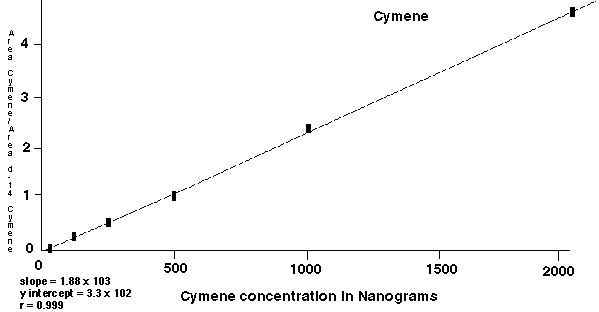
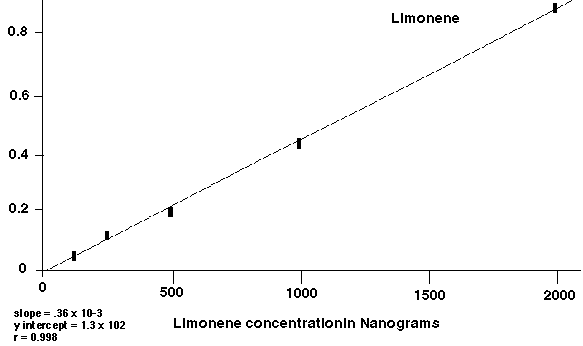
Figure 2 - Calibration Curves for the Quantification of Cymene and Limonene.
CARBONATED COLAS
Monterpenes such as myrcene, cymene, limonene, terpinene and terpinolene were identified in each of the colas examined (Figure 3) with the exception of a 25 year old cola which appeared to undergo oxidative degradation of the terpenes over time, resulting in the production of acetic acid and 2-ethyl hexanol ( Figure 4). Additional compounds which were found in the colas included the alcohols endo-fenchol and endo-borneol and 1,8-cineole, a chief constituent of oil of eucalyptus ( Figures 3-5). The flavors furfural and benzaldehyde were also detected in the cherry flavored colas (Figure 5). Even though each cola had its own distinct chromatograph, they were found to contain many common compounds.
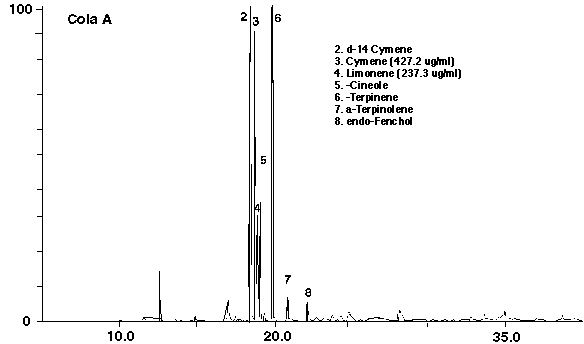
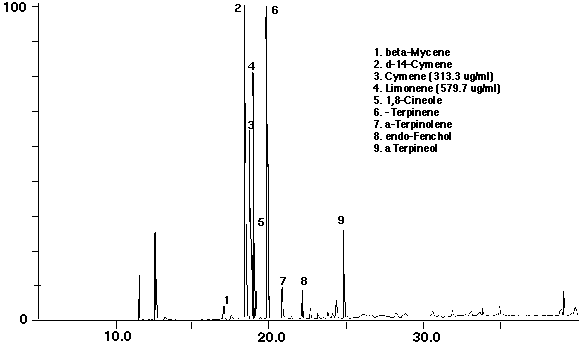

Figure 3 - Colas , 1 ml. Collected for 10 min at 15 ml/min With 15 ml/min Dry Purge and Thermally Desorbed At 200 Degrees C For 10 min
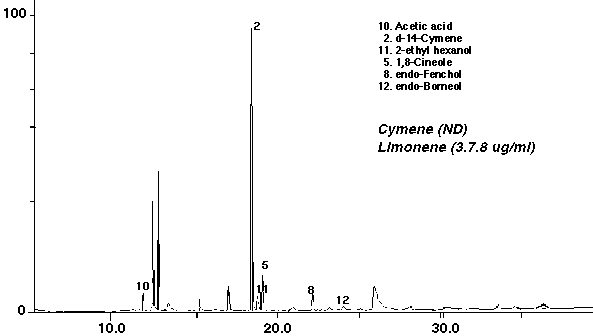
Figure 4 - Twenty-Five-Year-Old Cola, 1 ml. Collected For 10 min at 15 ml/min With 15 ml/min Dry Purge and Thermally Desorbed At 200 Degrees C For 10 min
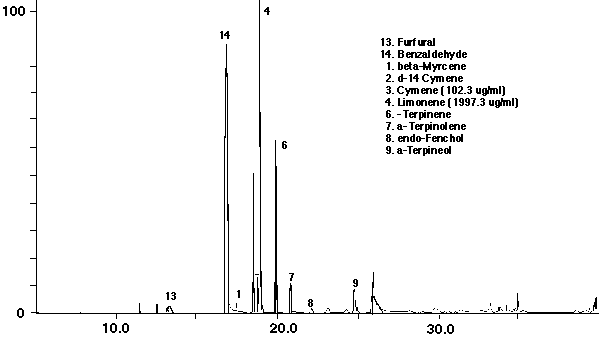
Figure 5 - Cherry Cola, 1 ml. Collected For 10 min at 15 ml/min With 15 ml/min Dry Purge and Thermally Desorbed At 200 Degrees C For 10 min
Increased shelf life had a significant effect on both the 2-year-old cherry flavored cola and the 25-year-old cola that were tested. Limonene concentrations significantly decreased in both colas from those of the control, while cymene concentrations increased with accompanying increases in cymene/limonene ratios (Table I). The more drastic effect occurred in the 25 year old cola where cymene was not detected and only a trace of limonene was present. This was probably due to increased oxidative reactions over time. This trend of decreased limonene concentrations and increased cymene/limonene ratios over time also occurred in the colas which were sampled at 4 days, 1 week and 3 weeks from an opened aluminum can.
TABLE I - Comparison of Cymene and Limonene in Colas With different Shelf Lives
Cymene(ug/ml) Limonene(ug/ml) Cym/Lim -------------------------------------- ------------ ------------- ------- Cherry Cola (1992 Control) l 101.9 1957.2 0.05 Cherry Cola (1990) 2 yr. old 195.5 104.9 1.86 Cola (1992 Control) 105.6 8930.9 0.01 Cola (1967) Not Detected 37.8 - Cherry Cola - freshly opened (Control) 101.9 1957.2 .05 Cherry Cola - opened (4 days) 66.1 585.7 .11 Cherry Cola - opened (1 week) 22.2 58.8 .38 Cherry Cola - opened (3 weeks) 14.2 15.2 .93
CONCLUSION
The Short Path Thermal Desorption System used in conjunction with the Liquid Purge System permits the identification and accurate quantification of trace levels of cymene and limonene and other volatiles and semi-volatiles in carbonated colas. Results indicate that limonene levels in the various colas decreased with respect to increased shelf life. It appears that the reduction in the limonene levels and not so much any changes in the cymene levels play a major role in the increased cymene/limonene ratios and in off-odor and unusual taste development over time. In the colas with a longer shelf life, as the 25-year-old cola that was examined, oxidative reactions occurred resulting in the degradation of the terpenoid compounds and in the formation of by-products like acetic acid and substituted alcohols. This technique has also been applied to other applications such as: quantification of benzene and toluene in food products (3), and flavors and fragrances in food products (4&5), commercial products (6) and plant material (7).
REFERENCES
Hartman, T.G., Karmas, K., Chen, J., Shevade, A., Deagro, M., and H. Hwang. 1992. Determination of
Vanillin, Other Phenolic Compounds, and Flavors in Vanilla Beans. ACS Symposium Series 506. Phenolic
Compounds in Food and Their Effects on Health I. Chi-Tang Ho, Chang Y. Lee, and Mon-Tuan Huang,
Editors. pp.60-76.
Manura, J.J., Overton, S.V., Baker, C.W. and Manos, J.N. 1990. Short Path Thermal Desorption-Design and
Theory. The Mass spec Source. Vol. XIII (4): 22-28.
Manura, J.J. 1993. Quantitation of BHT in Food and Food Packaging by Short Path Thermal Desorption.
LCGC Vol. 11 (2): 140-146.
Methodologies for the Quantification of Purge and Trap Thermal Desorption and Direct Thermal Desorption
Analyses. S.I.S. Application Note No. 9, September 1991.
Patt, J.M., Hartman, T.G., Creekmore, R.W., Elliott, J.J., Schal, C., Lech, J., and R.T. Rosen. 1992. The
Floral Odour of Peltandra Virginica contains Novel Trimethyl-2,5-Dioxabicyclo [3.2.1.] Nonanes.
Phytochemistry. Vol. 31 (2): 487-491.
Quantification of Naphthalene in a Contaminated Pharmaceutical Product by Short Path Thermal Desorption.
S.I.S. Application Note No. 10, May 1992.
Wiley, R.C., M.K. Louie and M.J. Sheu. 1984. Studies on Turpentine-Like Off-Odor in Cola. Journal of
Food Science. Vol. 49: 485-488, 497.

